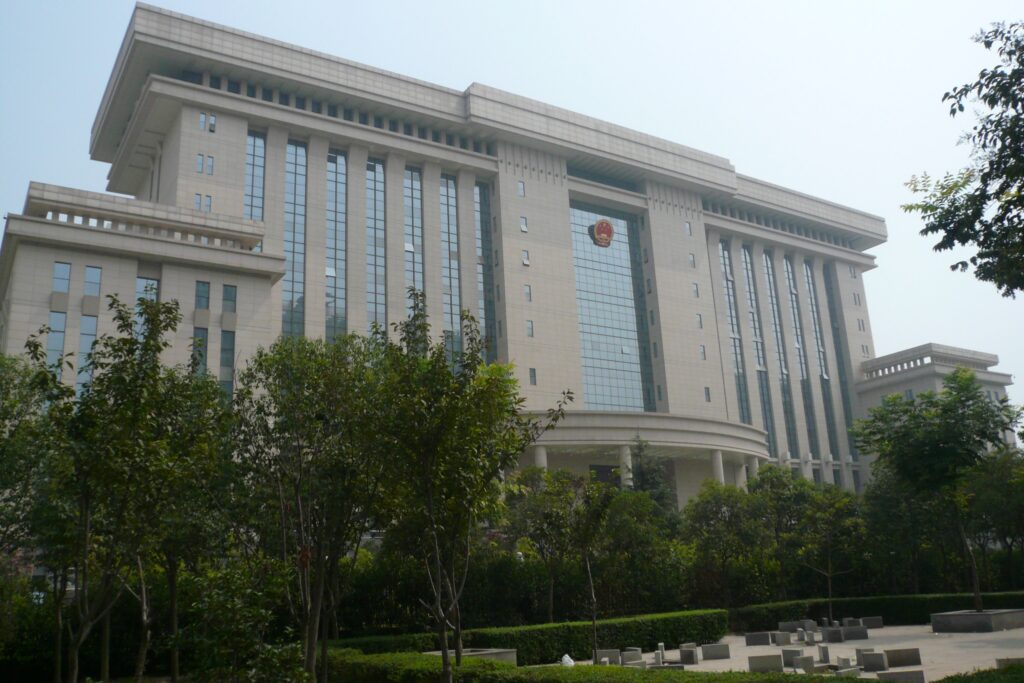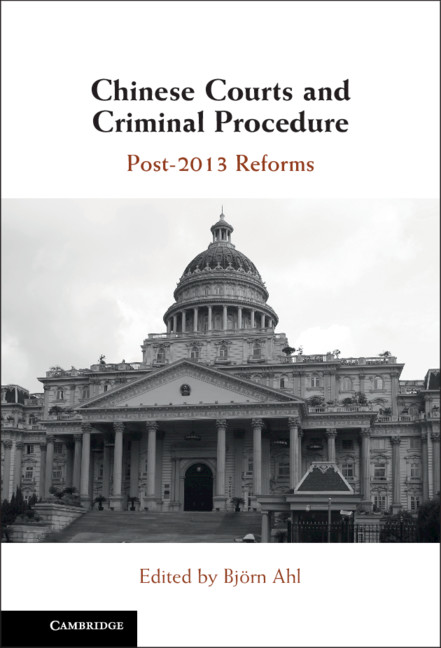Chinese Courts and Criminal Procedure – Post 2013 Reforms was published this year with Cambridge University Press

- In a nutshell: With its observations of a range of topics, what does this book tell us about the trajectory of criminal justice in China?
One of the main achievements of the book is to bring together contributions that look at Chinese court reforms and criminal procedure law reforms. Moreover, the book combines a wide range of analytical perspectives and themes in order to investigate questions that link institutional changes within the court system and legal environment with developments in criminal procedure law. The common denominator in the broad array of topics discussed in this volume is the multitude of forces attempting to influence the trajectory of judicial reform and criminal justice in China. The complex dynamics, and particular interests, of the numerous agents and subjects involved in the process intermingle with any undertaking to effective systemic change in the Chinese judiciary. These dynamics may play out in different ways. They may, for example, be mutually reinforcing, as in the case of the intra-court personnel reforms, heightened transparency, resilience against media influence and reform of the adjudication committees, all of which may result, to use the words of Fu Yulin, the author of chapter 2 of the book, in the by-product of a more independent judiciary. However, parallel reform projects can also interfere with one another, impeding the intended effects of each, as evidenced by the difficult position of the procuratorates in the criminal justice reforms, given that the envisioned trial-centred proceedings mandate the more prolific and active use of live witness testimony.
- Judicial Reform is an ongoing endeavour since reform and opening. (How) has the direction changed under the Xi Jinping administration?
Due to far-reaching limitations of civil and political rights, increased repression of political dissent and mass internment in Xinjiang, legal developments in the Xi Jinping era are generally perceived outside China as subject to unrestricted authoritarian rule that has largely side-lined legal institutions, including the Chinese courts. However, the court reforms of the post-2013 period have provided judges and courts with more autonomy in the adjudication of cases. Under Xi Jinping, court reforms have returned to the idea of rule-based governance, brought the court system back to the centre of dispute resolution, and emphasised professionalism, autonomous decision-making, the transparency and accountability of judges, and centralisation of the judiciary. The Decision on Governing the Country According to Law of the 4th Plenum, attempts at the normative regulation of inner-party affairs by strengthening rule-based governance and the October 2018 amendment of the People’s Court Organisation Law all underscore the regime’s efforts to formalise legal procedures and strengthen legality. Court reforms have taken a more radical turn than those passed under preceding administrations, as a vast range of measures have been introduced to render judges and the courts less susceptible to local government interference and increase the efficiency of the judiciary. The strengthening of the courts as professional, autonomous arbitrators of legal disputes was effected through both a centralised judicial authority and controlled experimental reform measures at the local level.
- Xi Jinping’s leadership has amended the Constitution three years back, among others lifting the term limits for his own rule. Among the changes made, which are most consequential for criminal procedure in China?
Apart from abolishing the term limits of the state president, the 2018 constitutional amendment established the National Supervision Commission as a new state organ that merged the anti-corruption agencies of the party and the state. Supervision commissions were also introduced at the local levels. The National Supervision Commission has now been afforded an independent constitutional status that allows it to exercise both administrative and criminal supervisory powers in supervising, investigating, disciplining and sanctioning public officials. Rather than constituting an independent state institution, the supervision commissions have absorbed state functions that are now directly controlled by Party disciplinary inspection commissions at the various administrative levels, the members of which simultaneously hold positions in the state’s supervision commissions. The supervision commissions are not subject to the legal constraints on investigative powers stipulated in the Criminal Procedure Law, although they enjoy de facto power to conduct criminal investigations and gather evidence that is admissible in criminal trials. The Supervision Law’s coverage has been extended to all public employees who exercise public power rather than being restricted to Party members alone, as under the previous scope of investigation by the disciplinary inspection commissions. Meng Ye in chapter 5 of the book provides an in-depth analysis of the supervision commissions.

- The volume zooms in on a number of themes in the reform of criminal procedure. What do the observations have to offer in response to the claim that the rule of law is a lost cause in China?
The answer to this question depends on how you define the rule of law. If we take the term in its liberal sense and require that the law effectively constrains all levels of government and comprehensively controls the political process, then the overall direction of procedural and institutional reforms during the post-2013 era is disappointing. In general, the dominance of the party over the law has been re-emphasised on the ideological and institutional levels. It is stressed that the effectiveness of the law hinges on permanent affirmation and supervision by the party. The reforms do not directly aim at improving the protection of rights of the individuals involved in criminal procedures. However, improvements in terms of the protection of rights may occur as by-products of some reform measures. Many court reforms are part of a general centralisation dynamic and aim at insulating courts from improper horizontal influence of local actors, while strengthening vertical control over the court system. What this change from ‘improper influence’ to ‘proper influence’ means for the development of a ‘socialist rule of law’ is difficult to measure. The court and criminal procedure law reforms are oriented towards unified application of the law, they rely on technology and data-driven innovations that reduce human discretion, they have enhanced professionalisation, transparency and vertical control of courts as well as given individual judges and panels of judges greater autonomy in adjudication. However, criminal procedure reforms aim at enhancing Party-state governance effectively control crime and political dissent in order to maintain Party supremacy and social stability. To sum up, the reforms have strengthened the instrumentalist aspects of law and formal legality but not necessarily due process or human rights protection.
- How can the role of the Supreme People’s Court be described in criminal procedure developments?
This issue is addressed in detail by Susan Finder in her chapter on how the SPC adopts judicial interpretations of the criminal procedure law. The SPC is the most important institutional actor linking court reform and criminal procedure reform, with the dynamics of both grounded in the administrative and legislative functions of the SPC. Those functions are distinct characteristics of China’s highest court that are not shared by the apex courts of other jurisdictions. Although the SPC has an important adjudicative function as an appeal court, its legislative function has elevated it to the role of a legislator. The SPC wields these powers through judicial interpretations that are often more relevant to adjudicative practice in procedural law than the laws passed by the NPC or its Standing Committee. Further, the SPC exercises administrative powers over the entire court system, including the design and implementation of court reforms in cooperation with the relevant party organs. The SPC’s judicial interpretation drafting process is an example of secluded, bureaucratic law-making in which the political interests of the CPC and the institutional interests of the SPC and the judiciary as a whole dominate.
- What are other actors exerting influence in the development of criminal justice and courts in China?
The book focuses on the Supreme People’s Court as a major actor of initiating and implementing institutional and procedural reforms. Yet we should not underestimate the role of the academia in the development of criminal procedure law and court reforms. Many of the reform measures were proposed by legal scholars and have been discussed for some time before they were taken up by the party-state leadership. Of course, legal scholars have no power to determine reform priorities or to take decisions about what kind of reform models shall be adopted, but Chinese legal scholarship is the most important intellectual resource from which decisionmakers draw.
- Developments in Chinese law have been informed by systems and laws in other countries. Does criminal procedure reform look to other countries for reference?
All major Chinese legal reforms in the last decades were preceded by comparative studies of legislation, scholarship and judicial practice of foreign jurisdictions. Apart from foreign jurisdictions, international human rights treaties that set standards for criminal trials have been a central reference point of academic discussions. However, nowadays debates about foreign legal models and their suitability for China only take place in the background. In contrast to earlier periods of the reform and opening period, official documents refrain from references to foreign or international law and place the indigenous Chinese experience at the centre. The widespread use of the terms ‘Chinese characteristics’ and ‘selective adaptation’ of foreign models indicate legal reform relies on indigenous resources and technology and data-driven innovations rather than on the adoption of ‘Western’ law. Indeed, Chinese legal institutions and procedural laws are quite distinct from those of liberal rule of law systems as the Chinese authoritarian system has certain features that determine the shape and operation of legal institutions and the law. For example, the supremacy of the Communist Party requires channels of ‘proper interference’ with judicial decision-making processes in order to effectuate its comprehensive overview of the implementation of law.
Contributors to the volume ‘Chinese Courts and Criminal Procedure‘, published with Cambridge University Press, include Xiaohong Yu, Yulin Fu, Susan Finder, Ye Meng, Alexandra Kaiser, Zhiyuan Guo, Kwai Hang Ng, Xin He, Michelle Miao, and Daniel Sprick. The editor Björn Ahl is Professor and Chair of Chinese Legal Culture, Cologne University and President of the European China Law Studies Association.
